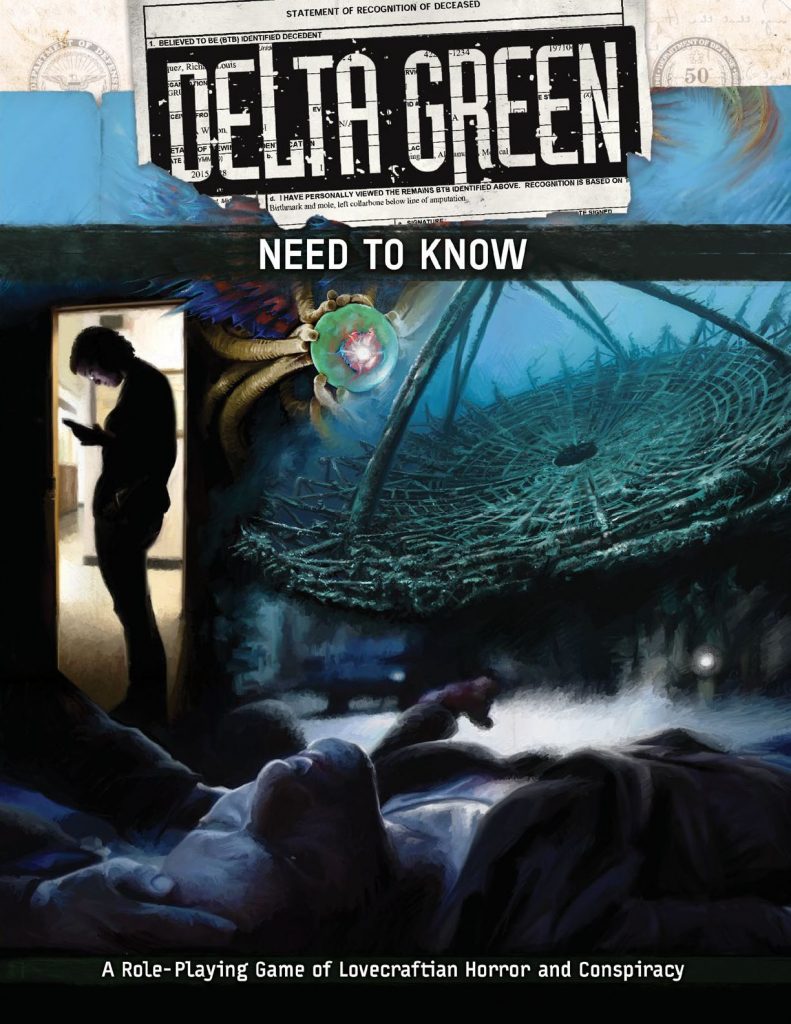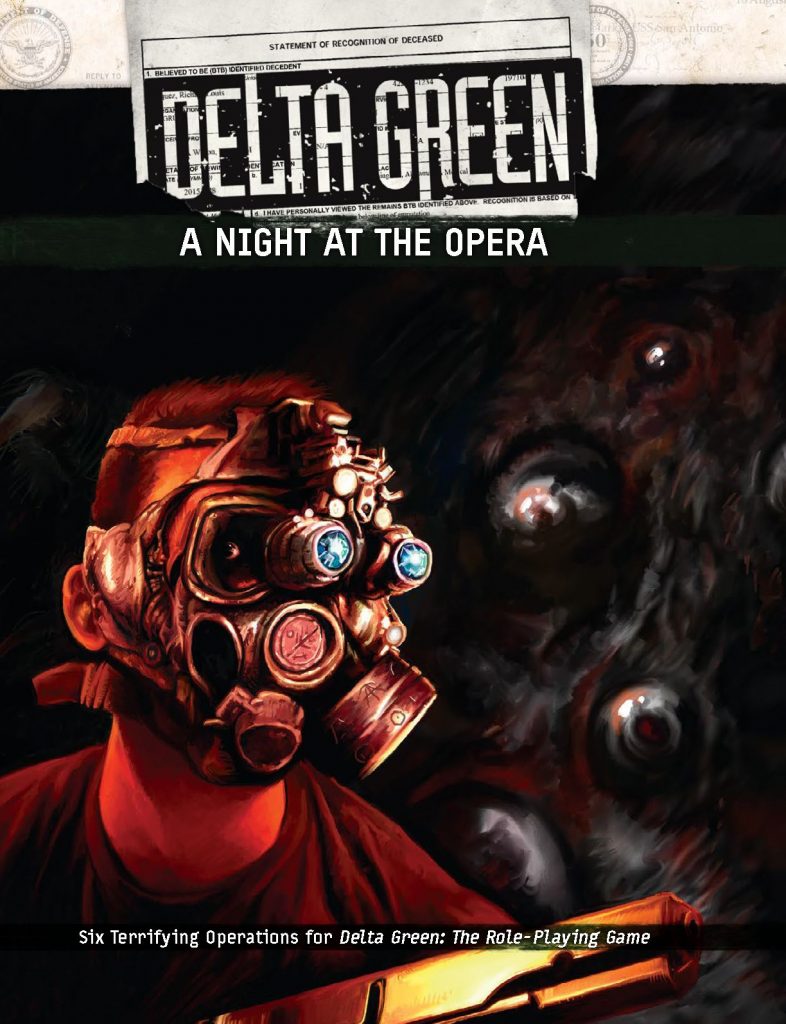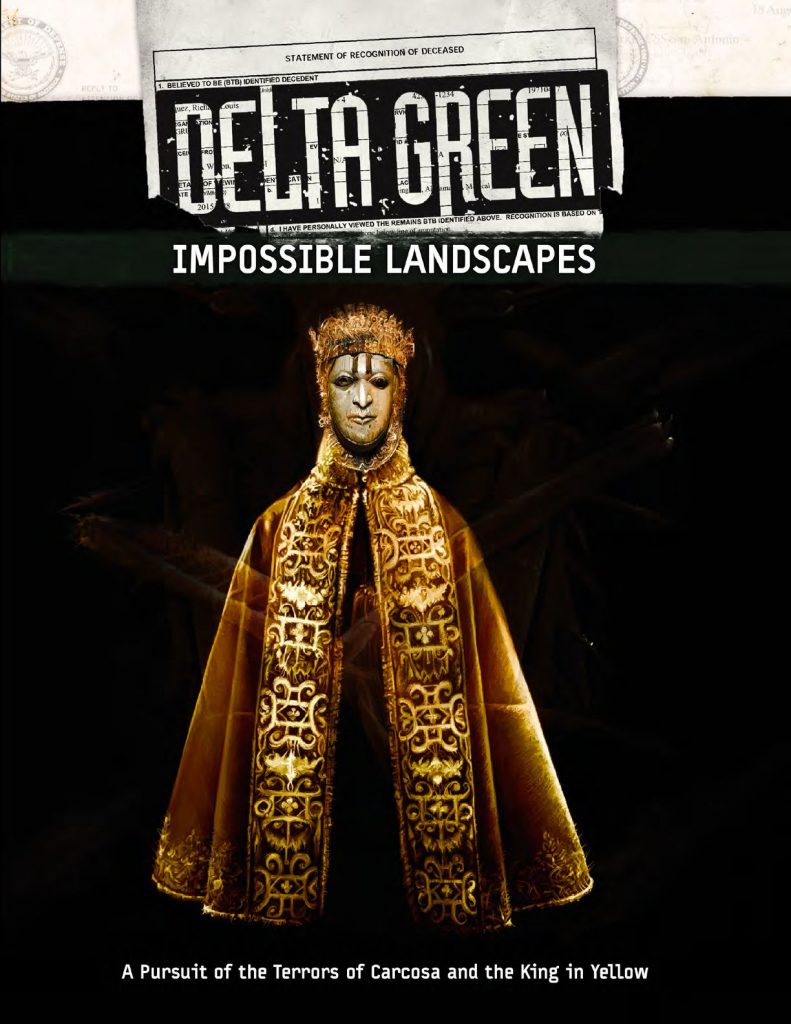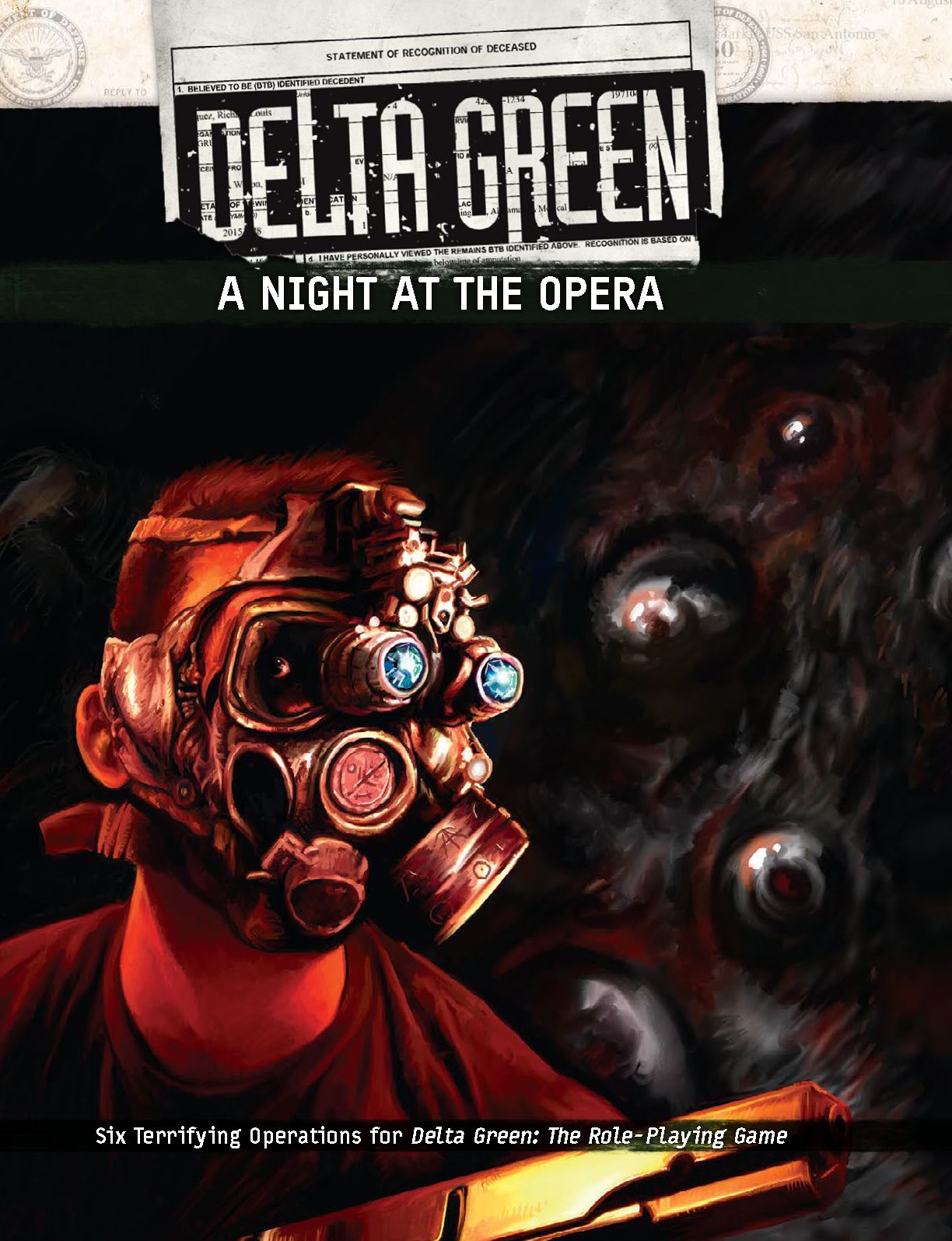For this week’s tabletop review let’s discuss Arc Dream’s Delta Green RPG, before segueing into 2 important supplements for the RPG the module collection “Night at the Opera” and the King in Yellow inspired campaign “Impossible Landscapes”. Delta Green took life as a Call of Cthulhu setting designed by John Scott Tynes, Adam Scott Glancy, and Dennis Detweiler in 1992. It is a modern setting in comparison to Call of Cthulhu’s frequent 1920’s/1930’s setting. (To be fair CoC has more than occasionally dipped into the modern as well).
The setting for Delta Green involves a clandestine organization hidden within the government itself that started soon after the Innsmouth raid (See Lovecraft’s The Shadow Over Innsmouth). The members of this organization are usually outsiders working for other government branches, who get called upon to work on missions to combat the Cthulhu Mythos and other world-ending supernatural horrors.
Delta Green saw a Kick-started relaunch in 2016 to much acclaim, and fanfare. If you play or have played Call of Cthulhu the gaming system at Delta Green’s core will be insanely familiar to you. It is built on top what appears to be a variant of Chaosium’s BRP (Basic Role Playing)system, but more on the 1-6th edition variant than the current 7th. The core differences in the systems in comparison to the current CoC system is the use of a “Bond” mechanic which also also makes Delta Green more of a “lifepath” game. The Bond’s in Delta Green tie a PC into a specific person or people whether that be their partner in DG, a wife, child, etc. Every time they come across a sanity-smashing event, they can project on to that bond, which will erode the bond, but prevent sanity loss and help keep the character going. Also, notable is that weapons also have lethality rating that one can roll under and do X amount of damage which helps simplify combat.

As for getting started with Delta Green, Arc Dream has made it stupid-easy. Go to Drive Thru RPG, and download “Need to Know”. If you just want to play, read the basic rules. If you want to be a “Handler” (GM the game), read the included scenario “Last Things Last”. It is a straight forward scenario, that will get you into the vibe of the game in an easy manner.
And now onto the books…

NIGHT AT THE OPERA
I don’t write my own adventures for games, and on the oft-chance that I do I wait until I’ve played the game as written enough times to understand the system fully. Hence, the book a Night at the Opera. Which contains 6 scenarios for Delta Green, which can be played individually or with some notes at the very beginning as a campaign (this includes some of the aforementioned life-path structure). As a quick aside a “Night at the Opera is not a reference to the Queen album or the Marx Bros. Film, but rather, it is the name given to missions for DG agents.
Night at the Opera begins with “Reverberations”, a scenario that involves a drug from the 90’s ending up back out on the streets of Chicago. This one involves the Tcho-Tcho, and some call backs to those familiar with DG from decades past. It’s almost the most straight-forward of the scenarios in the book. It would be best to run this early first, or after “Last Things Last” from the Need to Know book. Second up is “Viscid”, which has the agents following the death of a geneticist and his girlfriend, and how it ties into various rival conspiracies. The third, and arguably the most famous (if not best) “Music from a Darkened Room”, this is like the Delta Green version of Call of Cthulhu’s “The Haunting”, but more explicit. If The Haunting goes to 10, this goes to 11. It starts investigative, but then when the agents get into the house, things ramp up A LOT. To say anymore would ruin the experience, but this a classic for a reason.
The fourth scenario “Extremophilia” has a lot in common with the 2nd scenario Viscid. This one involves a disappearance, and an experiment gone awry, a rival conspiracy group, and a hefty Close Encounters of a Third Kind influence. If you’re playing these in order it’s kind of a must, if you’re dropping these into a campaign I’d make sure to separate this one out a while after Viscid. The first scenario “Star Chamber” is an interesting and bizarre treat, which the agents coming in behind a group of failed Delta Green agents. It involves interrogating the survivors of the mission, and trying to discern what happened and feels in many ways like a sci-fi Rashomon. The final scenario in the book is “The Observer Effect”. This one is a pulpy, cosmic horror scenario that sees the agents visiting the Department of Energy after some technology goes online, that possibly shouldn’t exist. This is a wild scenario involving disappearances, times loops, and will definitely take some work on the Handler’s part, but it is well worth the effort.

IMPOSSIBLE LANDSCAPES
I’m going to cut to the chase. I haven’t run this yet, my group just switched over from Call of Cthulhu to Cyberpunk Red, but reading this, I can see this 2022 release from Arc Dream (and written by Dennis Detweiler) falling into the pantheon of legendary TTRPG campaigns. Impossible Landscapes is made up of 4 scenarios “The Night Floors”, “A Volume of Secret Faces”, “Like a Map Made of Skin”, and “The End of the World at the End”. “The Night Floors kicks off the campaign in style, as a rewrite of Shane Ivey’s classic surrealist horror scenario. It expands and develops what was in the original version, so that it flows better into the structure of the campaign itself. The Night Floors scenario kicks off in the summer of 1995, with the follow up scenario taking place 20 years later in 2015 at a Boston psychiatric facility. Beyond that time makes no difference. You can have characters slot into additional operations between, however, due to the deadly nature of Delta Green as a game, if you want the same characters used at the beginning as at the end it’s not entirely recommended.
While cosmic horror by nature has a surrealist tone to it at times, or at least a dreamlike quality in some of the writings. It should be noted that a lot of the components of the genre do have a physical component especially in the years since games like Call of Cthulhu have taken off. This imagery is usually of slimy, tentacled creatures. While Impossible Landscapes is indeed a cosmic horror campaign, and does use Robert W. Chambers “The King In Yellow” as the primary influence. It is surrealist horror through and through. That means the Handler should try and channel less a physical atmosphere, but more an atmosphere of intangible fear, and of dreamlike terror. This reminded me of some of the Italian and Spanish horror films of the 60’s and 70’s that went off the narrative ramp like Mario Bava’s Lisa and the Devil, Dario Argento’s Suspiria and Inferno, and Jess Franco’s Virgin Among the Living Dead. The book’s introductory sections does touch upon the use of surrealism and how the campaign should flow. It also includes an example of play to those new to DG. It also touches upon the use of imagery and fear, and of course an introduction to Carcosa and the King in Yellow.
Both a Night at the Opera and Impossible Landscapes feature full color artwork of the absolute highest quality. Seriously, the imagery alone in the books is worth the price of admission. When that is coupled with the high quality of the writing (seriously, these are some of the greatest scenarios in horror TTRPG-dom) I can do nothing, but HIGHLY RECOMMEND not only Delta Green as a game, but Night at the Opera and Impossible Landscapes as required books for it.

